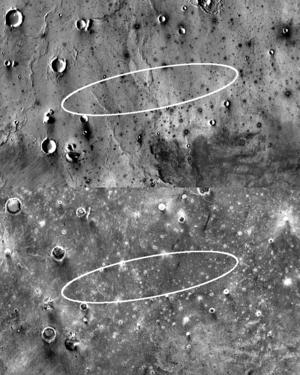THEMIS helps NASA choose site for next Mars lander
NASA's next Mars space probe, a lander named InSight, is due to touch down on the Red Planet in September 2016 with a mission focused on the planet's internal properties. Its landing place has been chosen with help from a Mars-orbiting heat-sensitive camera designed and operated at Arizona State University.
Working at nine infrared and five visual wavelengths, the Thermal Emission Imaging System (THEMIS) on NASA's Mars Odyssey orbiter has been in operation since early 2002. Its data have let scientists create a near-global map of Martian surface properties.
More recently, THEMIS has been surveying the rocks, sand, dust, and surface materials across InSight's four candidate landing areas. NASA has now picked as the prime landing site one location in Elysium Planitia, a region where ancient lava flows cover the ground.
"To land a probe safely on Mars, you need to come down in a flat, smooth place," says Jonathon Hill, of Arizona State University's Mars Space Flight Facility, part of ASU's School of Earth and Space Exploration (SESE). A staff member and Ph.D. student in planetary science, Hill has a day-to-day role in targeting specific areas of Mars for THEMIS to image.
"Picking a safe place," he says, "means the landing site can't be full of big rocks or covered in a thick layer of dust." By measuring how quickly the ground cools at night or warms in sunlight, THEMIS can tell the proportion of rocks and dust on the ground and thus help paint a picture of what awaits the lander at the surface.
InSight (short for Interior Exploration using Seismic Investigations, Geodesy and Heat Transport) carries two main instruments, a heat-flow probe and a seismometer, both being deployed using a robotic arm. The heat probe requires that the ground within reach of the arm be penetrable by the probe, which will hammer itself into the soil to a depth of three to five yards, or meters.
"InSight's mission planning team worked closely with us to find places with a suitable surface for the spacecraft to go," says Hill. Additional data and imaging came from the High Resolution Imaging Science Experiment (HiRISE) on NASA's Mars Reconnaissance Orbiter.
While THEMIS' main contribution to NASA's site choice was its infrared data, THEMIS is also currently taking visual images of the entire landing site ellipse, which represents the target zone. The visual images each cover a smaller area, but have about five times sharper resolution than the infrared ones.
Scouting ahead is old story
Checking out a Martian landing site ahead of touchdown is a now-familiar role for THEMIS, says ASU's Philip Christensen. A Regents' Professor of Geological Sciences in SESE, Christensen is the designer and principal investigator for the THEMIS camera.
"Before NASA's Curiosity Mars rover landed in Gale Crater in 2012," he says, "THEMIS surveyed the surface materials at dozens of candidate landing areas scientists were evaluating." And earlier, he notes, "THEMIS selected the landing site for NASA's Phoenix Mars probe, which landed in 2008, by mapping the rocks and dust at numerous potential sites to find the safest one."
Unlike NASA's recent Mars landers, InSight is not a rover. Built using the same flight platform as the Mars Phoenix lander, InSight will touch down in one place and stay there for its entire mission, projected to last two Earth years.
But immobility means that if InSight came down in a location that's too dusty or rocky, it wouldn't be able to drive away from the landing site and find a better location. This raised the stakes on where it lands, and that's where THEMIS has played its part.
Says Christensen, "We're delighted to help find a good landing spot for InSight. And also to be helping scientists learn more about Mars, and deepen our picture of this intriguing world next door to Earth."
Other News & Discoveries

Day and night infrared views of InSight landing ellipse
Two THEMIS infrared (heat-sensitive) images show InSight's landing ellipse by day (top) and by night. The day view shows a lava plain dotted with craters and lava ridges. The night view reveals rocky areas as bright because they still hold daytime warmth. (The white rings in the image mark the rocky rims of large and small impact craters.) Areas covered with dust, however, cool quickly after sundown, becoming quite cold as the Martian night wears on. THEMIS sees these areas as dark. The landing ellipse measures 81 miles (130 kilometers) long by 17 miles (27 km) wide.
NASA/JPL-Caltech/Arizona State University
Download Original